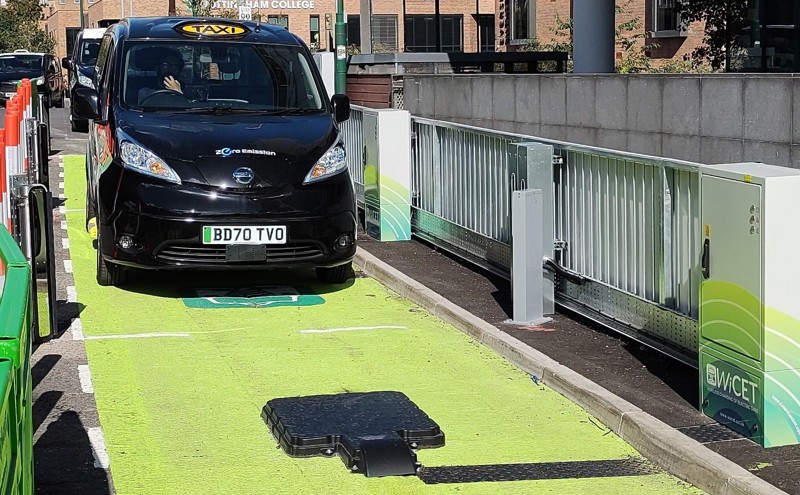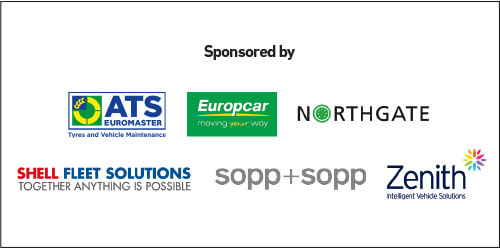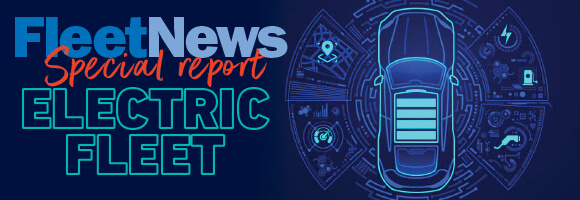
A trial in Nottingham which saw a fleet of electric and range-extender taxis wirelessly charge while they were waiting for their next fare has helped generate much interest from fleets in the potential of the technology.
The Wireless Charging of Electric Taxis (WiCET) initiative ran for four months, ending last January.
It saw five 11kW induction charging pads installed in the road surface in the taxi rank in Trent Street, outside the central railway station.
Nine vehicles – five LEVC TXs and four Nissan eNV200 Dynamo taxi conversions – were modified so they could charge when the driver, using the guidance of an HMI screen in the cabin, aligned their vehicle over a ground pad.
The system was able to differentiate between cars thus enabling the appropriate drivers to be billed through a web-based app, meaning the drivers had no need to leave their vehicles during charging.
“The core technology worked very well and there’s been high levels of interest in the trial, including from the NHS which is very appreciative of the possibilities for ambulances,” says Richard Sander, technical consultant and project manager at Cenex, which led the initiative.
The system used a resonant induction method and the charging area was protected by a ‘light curtain’ system which, if broken, stopped the charging.
The light curtain was very much an element of the innovation trial but will not be included in commercial deployments.
A further system was able to detect foreign metal objects which would heat up if present on the pad during charging.
The wireless charging system achieved 90% power transfer efficiency, which makes it comparable with plug-in chargers.
“The charging facility was aimed at top-up charging rather than being a replacement for plug-in charging,” says Sander.
He likens this approach to ‘grazing’, where the battery is kept at a consistent state of charge instead of running the battery down and then recharging fully.
However, Sander says the drivers in the trial struggled with this concept.
“They didn’t really appreciate the opportunity of regular top-up charging, which is something worth thinking about for other potential user groups going forward,” he adds.
“Because they were looking at it as a direct replacement for plug-in charging, they saw the 11kW rating as being too low.”
However, the data collected in the trial shows that regular topping up on the rank would have been sufficient for the majority of operating duty cycles seen in the daily shifts.
The 11kW power limit was imposed by the technical standard applied as the system was developed.
The power level will increase in future, and some systems are already delivering a higher output.
Other findings concluded that the communication ‘handshake’ sequence, which engages the vehicle to the ground system, was too slow.
“If the system had operated to the ISO 15118-20 vehicle-to-grid communications standard it would have taken around seven seconds to achieve connection from the vehicle overlapping the ground pad,” says Sander.
“Even when we worked around the standard, it still took two seconds to make the comms connection and share alignment data. That’s a really key learning point.”
There were also reliability issues around Wi-Fi dropouts affecting the connection between vehicle and ground systems, while the protection systems were not well suited and adjusted to real-world applications.
“All these wider system issues will be resolved for commercial deployment.
Overall findings indicated that wireless charging is viable and would have numerous benefits for many fleets, says Sander.
“Some benefits will be very obvious, some less so,” he adds. “It’s very easy to use once the driver is used to it.
“They drive up, line up and the EV starts charging until they drive away. It avoids having any cables lying around which can get damaged or be trip hazards, so it’s perfect for operational working areas.
“There are not any exposed electrical contacts, so it’s well suited to dirty environments; there are no moving mechanical parts, meaning there is less wear and tear.
“There is the potential to deploy it with minimal or no street furniture/hardware on the charging site, and if you can deploy it for top-up charging you could potentially reduce the size and weight of the propulsion battery within the vehicle.”
Potential fleet uses include taxis and private hire vehicles, emergency vehicles, autonomous vehicles, depot charging and micromobility solutions, he says.
“There are many commercial sectors where it may be perfect on its own, but it could also be deployed to be complementary to plug-in charging,” adds Sander.
“We also know of at least two companies that are working on bi-directional wireless charging, so V2G (vehicle-to-grid) may also be possible.”
He says there will be a premium cost for fitment of the system to the vehicle, and to the groundside charging hardware compared with a plug-in system, but, in many use cases, the convenience and operational benefits will easily justify that higher initial investment.
Our latest Electric Fleet special report will help organisations take the next step to fully decarbonise their fleets, including:
- The new rules which slash EV charging infrastructure costs for fleets
- Importance of looking after charging cables
- Increase EV sustainability with a battery energy storage system
- Learnings from a wireless charging trial
- Electric vehicles coming soon






















Login to comment
Comments
No comments have been made yet.